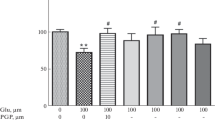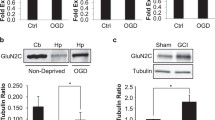Abstract
Excessive activation of glutamate receptors of the N-methyl-d-aspartate (NMDA) subtype is considered a relevant initial step underlying different neurodegenerative diseases. Recently, with the approval of memantine to treat Alzheimer dementia, NMDA receptors have regained clinical interest. Accordingly, the development and validation of NMDA receptor antagonists is being reconsidered. We recently identified a family of trialkylglycines that act as channel blockers of the NMDA receptor. Their neuroprotective activity against excitotoxic insults remains elusive. To address this issue, we first characterized the contribution of glutamate receptor sub-types to hippocampal death in culture as a function of days in culture in vitro (DIV). Whereas at 7 DIV neither NMDA nor glutamate produced a significant neuronal death, at 14 and 21 DIV, NMDA produced the death of 40% of the neurons exposed to this receptor agonist that was fully protected by MK-801. Similar results were obtained for l-glutamate at 14 DIV. In contrast, when neurons at 21 DIV were used, glutamate killed 51.1±4.9% of the neuronal population. This neuronal death was only partially prevented by MK-801, and fully abrogated by a combination of MK-801 and 6-cyano-7-nitroquinoxaline-2,3-dione (CNQX). Glucose deprivation injured 37.1±9.2% of the neurons through a mechanism sensitive to MK-801. The family of recently identified N-alkylglycines tested protected neurons against NMDA and glucose-deprivation toxicity, but not against glutamate toxicity. Noteworthy, N-alkylglicines with a moderate protection against NMDA-induced toxicity strongly protected from β-amyloid toxicity. Collectively, these findings imply both NMDA and non-NMDA receptors in excitotoxicity of hippocampal neurons, and suggest that blockade of NMDA receptors alone may not suffice to efficiently abrogate neurodegeneration.
Similar content being viewed by others
References
Choi, D. W. and Rothman, S. M. (1990) The role of glutamate neurotoxicity in hypoxic-ischemic neuronal death. Annu. Rev. Neurosci. 13, 171–182.
Ankarcrona, M., Dypbukt, J. M., Bonfoco, E., et al. (1995) Glutamate-induced neuronal death: a succession of necrosis or apoptosis depending on mitochondrial function. Neuron 15, 961–973.
Nicotera, P., Ankarcrona, M., Bonfoco, E., Orrenius, S., and Lipton, S. A. (1997) Neuronal necrosis and apoptosis: two distinct events induced by exposure to glutamate or oxidative stress. Adv. Neurol. 72, 96–101.
Garthwaite, J. (1995) NMDA receptors, neuronal development, and neurodegeneration, in The NMDA receptor (Ed. Collingridge, G.L.), Oxford University Press, Oxford, pp. 428–457.
Chase, T. N. and Oh, J. D. (2000) Striatal mechanisms and pathogenesis of parkinsonian signs and motor complications. Ann. Neurol. 47 (Suppl. 1), 122–129.
Heintz, N. and Zoghbi, H. Y. (2000) Insights from mouse models into the molecular basis of neurodegeneration. Annu. Rev. Physiol. 62, 779–801.
Choi, D. W. (1988) Glutamate neurotoxicity and diseases of the nervous system. Neuron 1, 623–634.
Choi, D. W. (1995) Calcium: still center-stage in hypoxic-ischemic neuronal death. Trends Neurosci. 18, 58–60.
Collingridge, G. L. and Lester, R. A. J. (1989) Excitatory amino acid receptors in the vertebrate central nervous system. Pharmacol. Rev. 40, 143–210.
Ferrer-Montiel, A., Merino, J. M., Blodelle, S. E., et al. (1998) Selected peptides targeted to the NMDA receptor channel protect neurons from excitotoxic death. Nature Biotechnol. 16, 286–291.
During, M. J., Symes, C. W., Lawlor, P. A., et al. (2000) An oral vaccine against NMDAR1 with efficacy in experimental stroke and epilepsy. Science 287, 1453–1460.
Tai, K. K., Blondelle, S. E., Ostresh, J. M., Houghten, R. A., and Montal, M. (2001) An n-methyl-d-aspartate receptor channel blocker with neuroprotective activity. Proc. Natl. Acad. Sci. USA 98, 3519–3524.
Monaghan, D. T. and Cotman, C. W. (1985) Distribution of n-methyl-d-aspartate sensitive l-[3H]glutamate binding sites in rat brain. J. Neurosci. 5, 2909–2919.
Planells-Cases, R., Montoliu, C., Humet, M., et al. (2002) Identification and characterization of an N-alkylglycine-based NMDA receptor open channel blocker with in vivo neuroprotectant activity. J. Pharmacol. Exp. Ther. 302, 163–173.
Mattson, M. P., Chan, S. L., and Duan, W. (2002) Modification of brain aging and neurodegenerative disorders by genes, diet, and behavior. Physiol. Rev. 82, 637–672.
Selkoe, D. J. (1989) Biochemistry of altered brain proteins in Alzheimer’s disease. Annu. Rev. Neurosci. 12, 463–490.
Yankner, B. A., Duffy, L. K., and Kirschner, D. A. (1990) Neurotrophic and neurotoxic effects of amyloid beta protein: reversal by tachykinin neuropeptides. Science 250, 279–282.
Montoliu, C., Humet, M., Cannales, J. J., et al. (2002) Prevention of in vivo excitotoxicity by a family of trialkylglycines, a novel class of neuroprotectants. J. Pharmacol. Exp. Ther. 301, 29–36.
Brauner-Osborne, H., Egebjerg, J., Nielsen, E. O., Madsen, U., and Krogsgaard-Larsen, P. (2000) Ligands for glutamate receptors: design and therapeutic prospects. J. Med. Chem. 43, 2609–2645.
Martin, R. L., Lloyd, H. G., and Cowan, A. I. (1994) The early events of oxygen and glucose deprivation: setting the scene for neuronal death? Trends Neurosci. 17, 251–257.
Author information
Authors and Affiliations
Corresponding author
Rights and permissions
About this article
Cite this article
Valera, E., Fernández-Salguero, P.M., Planells-Cases, R. et al. Neuroprotection against excitotoxicity by N-alkylglycines in rat hippocampal neurons. Neuromol Med 2, 271–280 (2002). https://doi.org/10.1385/NMM:2:3:271
Received:
Accepted:
Issue Date:
DOI: https://doi.org/10.1385/NMM:2:3:271




